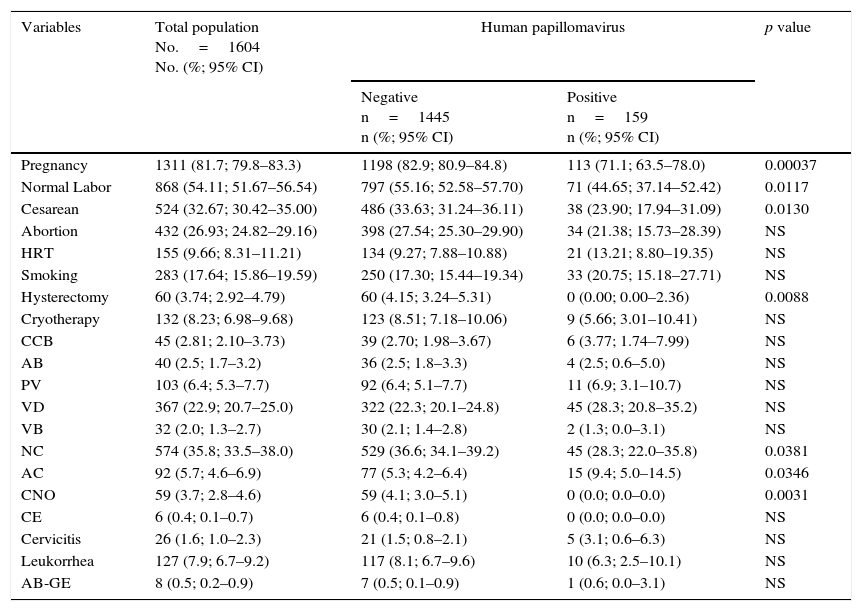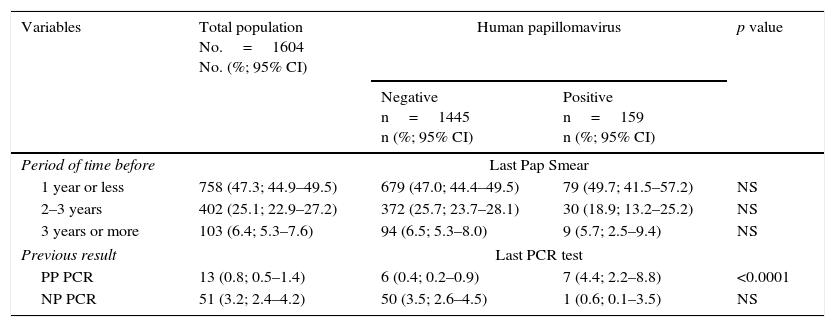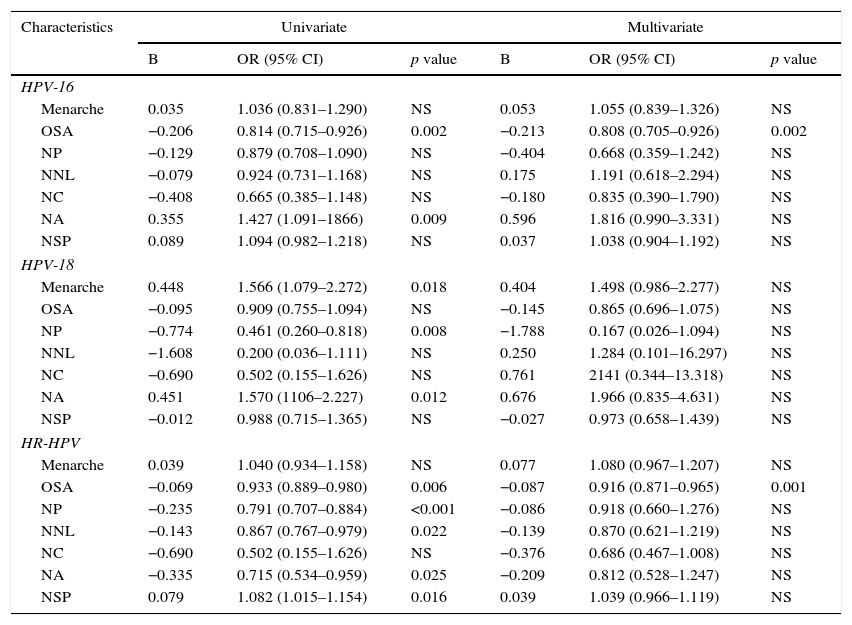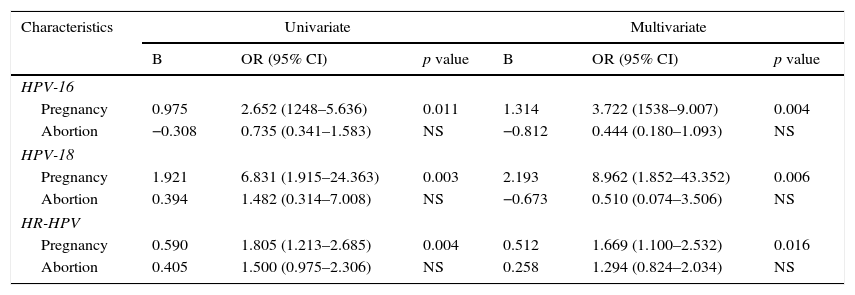To analyze the prevalence of human papillomavirus (HPV) infection and the possible epidemiological association with conditions of clinical relevance in women.
Materials and methodsA cross-sectional study from Mexico City was conducted from January 2012 to December 2014. HPV molecular detection was performed on cervical samples. Data were analyzed with appropriated statistic tests.
ResultsA total of 1604 females (median 47, interquartile range 38–54) were analyzed. Global prevalence of infection for any HPV is 9.91% (95% CI 8.6–11.3). An association between infection with 16-HPV and number of abortions (NA) (OR=1.427; 95% CI 1.091–1.866), by univariate regression model (UVRM) was estimated. Moreover, menarche (OR=1.566; 95% CI 1.079–2.272), NA (OR=1.570; 95% CI 1.106–2.227) and number of pregnancies (NP) (OR=0.461; 95% CI 0.260–0.818) have a direct and inverse association with infection by genotype 18 of HPV, respectively. Also, infection with HR-HPV genotypes has an inverse association with NP (OR=0.791; 95% CI 0.707–0.884) by normal labor (OR=0.867; 95% CI 0.767–0.979) and NA (OR=0.715; 95% CI 0.534–0.959) (UVRM), and a direct association with number of sexual partners (OR=1.082; 95% CI 1.015–1.154). Onset of sexual activity has an inverse association with infection by genotype 16- (UVRM: OR=0.814; 95% CI 0.715–0.926; multinomial regression model (MNRM): OR=0.803; 95% CI 0.702–0.918) and HR-HPV (UVRM: OR=0.933; 95% CI 0.889–0.980, and MNRM: OR=0.912; 95% CI 0.867–0.959), all p values were lower than .03.
ConclusionsPrevalence of HPV cervical infection is different according to age and it is associated with several medical conditions of clinical relevance in women.
Analizar la prevalencia de la infección por el virus del papiloma humano (VPH) y la posible asociación epidemiológica con las situaciones de relevancia clínica en las mujeres.
Material y métodosSe llevó a cabo un estudio transversal en la ciudad de México desde enero de 2012 a diciembre de 2014. Se realizó la detección molecular del VPH sobre muestras cervicales. Los datos se analizaron utilizando las pruebas estadísticas adecuadas.
ResultadosSe analizó a un total de 1.604 mujeres (mediana 47, rango intercuartílico 38-54). La prevalencia global de infección para cualquier VPH fue del 9,91% (IC 95% 8,6-11,3). Se calculó la asociación entre la infección por VPH-16 y el número de abortos (NA) (OR=1,427; IC 95% 1,091-1,866) mediante el univariate regression model (UVRM, «modelo de regresión univariada»). Además, la menarquia (OR=1,566; IC 95% 1,079-2,272), el NA (OR=1,570; IC 95% 1,106-2,227) y el número de embarazos (NE) (OR=0,461; IC 95% 0,260-0,818) tienen una asociación directa e inversa con la infección con el genotipo 18 del VPH, respectivamente. También, la infección por los genotipos VPH-HR tiene una asociación inversa con el NE (OR=0,791; IC 95% 0,707-0,884), los partos normales (OR=0,867; IC 95% 0,767-0,979) y el NA (OR=0,715; IC 95% 0,534-0,959) (UVRM), y una asociación directa con el número de parejas sexuales (OR=1,082; IC 95% 1,015-1,154). El inicio de la actividad sexual tiene una asociación inversa con la infección por el genotipo 16 (UVRM: OR=0,814; IC 95% 0,715-0,926; multinomial regression model (MNRM, «modelo de regresión multinomial»): OR=0,803; IC 95% 0,702-0,918) y VPH-HR (UVRM: OR=0,933; IC 95% 0,889-0,980; y MNRM: OR=0,912; IC 95% 0,867-0,959). Todos los valores de p fueron inferiores a 0,03.
ConclusionesLa prevalencia de la infección cervical por VPH es diferente en relación con la edad, y está asociada a diversas situaciones médicas de relevancia clínica en las mujeres.












